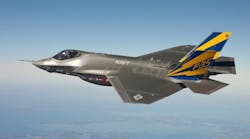U.S. Defense Secretary James Mattis has ordered reviews of Lockheed Martin Corp.’s F-35 Joint Strike Fighter and plans for Boeing Co. to build new Air Force One presidential aircraft, two high-profile contracting programs that President Donald Trump has singled out for criticism.
Mattis issued the reviews in order to “inform programmatic and budgetary decisions, recognizing the critical importance of each of these acquisition programs,” Navy Captain Jeff Davis, a Pentagon spokesman, said in a statement Friday. “This action is also consistent with the president’s guidance to provide the strongest and most efficient military possible for our nation’s defense.”
In December, Trump tweeted that F-35 costs are “out of control,” and this month he boasted of “the massive cost reductions I have negotiated on military purchases,” without identifying which projects he was referring to. Trump extracted general promises to cut costs on the F-35 and on the new Air Force One after meetings with the chief executive officers of the companies, which are the two biggest U.S. government contractors.
The F-35 is the Pentagon’s most expensive weapons program, at a projected cost of $379 billion, although defense officials under former President Barack Obama maintained that the program’s days of unending overruns and delays were past.
Presidential Aircraft
“We have been responsive in providing information to the Trump administration and we look forward to continuing that dialogue as this process moves forward,” Todd Blecher, a Boeing spokesman, said in a phone interview. A Lockheed representative didn’t respond to a request for comment.
Lockheed fell 1.1% to $252.17 at 2:51 p.m. New York time. Boeing declined 1% to $167.45.
For Air Force One, Mattis said the review will identify how to “substantially reduce the program’s costs.”
The Pentagon has budgeted $3.2 billion through fiscal 2021 for research and development, construction and acquisition of two of the aircraft used by presidents, with more spending anticipated after that, according to Kevin Brancato, a government contracting analyst with Bloomberg Government.
The plane itself is a relatively small portion of the cost, he said. Air Force One planes are flying fortresses, outfitted to highly classified specifications, which include secure communications and antimissile defenses.
F-35 Alternative
In a memorandum on the F-35, Mattis said the deputy secretary of defense will oversee the review to “determine opportunities to significantly reduce the cost” of the fighter jet, saying it should begin immediately.
Mattis’s directive gives Boeing a chance--even if it’s a long-shot--to reenter a program it lost to Lockheed in 2001, when its candidate for a stealthy fighter was passed over.
The new defense secretary ordered a study of whether Boeing’s older F/A-18 Super Hornet could be upgraded to provide a less costly alternative to the Navy version of the F-35.
The deputy defense secretary “will oversee a review that compares F-35C and F/A-18E/F operational capabilities and assesses the extent that F/A-18E/F improvements (an advanced Super Hornet) can be made in order to provide a competitive, cost effective, fighter aircraft alternative,” Mattis said in his directive.
The Navy version of the F-35 is easier to target than those tailored for the Air Force and Marine Corps because it’s not scheduled to become operational until February 2019.
Relative Stealthiness
While the F-35 has advantages over the Boeing plane, such as its greater stealth capabilities, that’s not always necessary, said Howard Rubel, an analyst with Jefferies.
“The value you get for the F-35 on a maintenance basis and the differentials that you get relative to range, payload and speed don’t always warrant it being the first choice,” he said in a telephone interview.
Under current plans, the Pentagon is scheduled to increase purchases of the F-35 in the coming fiscal year 2018 budget to 70 from 63 this year. Then, the number would grow to 80 in fiscal 2019. There’s also a pending “block buy” of 450 aircraft in the coming years as the Pentagon seeks a total fleet of 2,443, including 1,763 for the Air Force.
Michael Gilmore, the recently departed director of the Pentagon’s testing office, said in a memo this month to senior Pentagon leaders that the Trump administration should “rigorously and comprehensively review” the F-35. He cited the fighter’s “significant, well-documented deficiencies in critical combat capabilities.”




